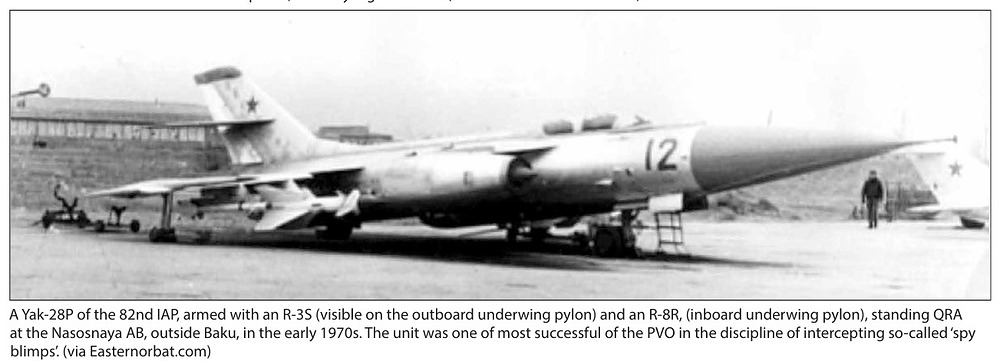- Yes
- No
Yakovlev Yak-28P
Aircraft:
Yakovlev Yak-28P [NATO code: Firebar]
Classification:
Jet Interceptor
Description:
The Yak-28P was a variant of the Yak-25 interceptor and never saw official service. However, for about 20 years from 1963, IA-PVO was practically operated in parallel with the test.
The early Yak-28P was capable of mounting the R-8M1R (R-30R) SARH AAM and the R-8M1T (R-30T) IRH AAM on two underwing hardpoints. It was hoped that firing two missiles in quick succession, one radar-guided and the other infrared-guided, would increase the probability of a kill.
Compared to the Su-9, which had been deployed since 1958, it was equipped with a more sophisticated weapons system, and not only had a wider radar detection range, but also a better missile range.
Prototypes were equipped with the Tumansky R-11AF-300 engine, which was replaced with the more powerful R-11AF2-300 engine in production. The space that was used as a bomb bay on other models was used as a fuel tank.
The Yak-28P was the most produced of the series, with a total of 435 built between 1962 and 1967.
Later Yak-28Ps received several improvements. First, the engine air intake was extended forward. The nose was then lengthened to improve acceleration in supersonic flight. Additional underwing pylons were added to accommodate two R-3S IRH AAMs.
According to Yefim Gordon’s book “Yakovlev Yak 25 26 27 28 Aerofax S. (p77)”, in 1970 the Yak-28P was armed with R-40 and R-60 AAMs and was tested, but there is no evidence.
The Yak-28P was largely replaced by the Tu-128 in 1968, but some units preferred the Yak-28P and continued to use it until it was replaced by the Su-27P in 1988.
In War Thunder:
This variant has no cannons, no bombs, no rockets. An aircraft armed only with air-to-air missiles. Like the Yak-28B, it has low maneuverability, but it will be able to accelerate with its powerful thrust and climb easily. And, much like the French S.O.4050 Vautour IIN(late), we can expect it to become an “Interceptor Spawn” jet.
Depending on the BR, it will act faster than anyone else and become an interceptor capable of preemptive strikes with SARH missiles with a range of 35km. It can be a nightmare, especially for “bomber spawn” aircraft.
But the problem is missile performance. The R-8M1R or R-98M1R SARH AAMs are designed to target large aircraft and are not very mobile. May not be useful against fighters.
Apart from the SARH AAM, it is also possible to carry the R-8M1T or R-98M1T missiles, which are medium-range AAMs of the IRH. Although it has a rear aspect and poor maneuverability, it has a range of 18 km, which is longer than other short-range missiles. Later variants can carry two additional R-3Ss, but you’ll have to catch them off guard anyway.
In conclusion, although acceleration, climbing power, and maximum speed are perfect, the impression is that it is an interceptor with poor mobility and weak missiles. The R-8 series missiles have not yet been implemented in War thunder, so I cannot make a clear evaluation, but they should be interceptors that can be active at low BR like the S.O.4050 Vautour IIN (late).
Due to the lack of information on the Yak-28P that has tested the R-40 and R-60, we do not know if these can be equipped at this time. Please provide any additional information or photos.
Specification:
Data from Yefim Gordon’s “Yakovlev Yak 25 26 27 28 Aerofax S. (p89)”
Powerplant: 2x R-11AF2-300
Thrust kgp (ibst): 2x 6,100 (2x 13,448)
Length overall: 20.55 m
Height on ground: 4.3 m
Wing span: 11.64 m
Wing area: 35.25 m2
Normal TOW: 16,065 kg
Fuel load: 5,450 kg
Top Speed at 12,000 to 13,000 m: 1,840 km/h
Service ceiling: 16,000 m
Range effective: 2,150 m
Endurance: 2 hrs 31 min
Take off run: 1,300 m
Landing run without drag chute: 1,200 m
Landing run with drag chute: 620 m
G load: maximum 6.0 G
Armament (Early production): 2x hard-point (R-8M1T and R-8M1R)
Armament (Late production): 2x inside hard-point (R-98M1T and R-98M1R) and 2x outside hard-point (R-3S)
Radar: RP-11 Oryol-D (NATO: Eagle-D)
More Picture:

The prototype Yak-28P late was equipped with additional hardpoints inside the wings. This was later changed to the outside.


Side view for easy comparison of early Yak-28P and late Yak-28P. You can see that the nose and air intake have been extended.

Source:
Bill Gunston YAKOVLEV AIRCRAFT SINCE 1924 ISBN 978-0851778723
Yefim Gordon Yakovlev, Yak-25/-26/-27/-28: Yakovlev’s Tactical Twinjets ISBN 978-1857801255









